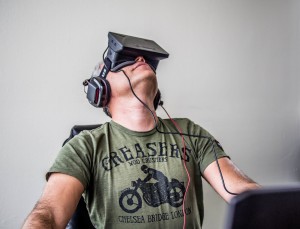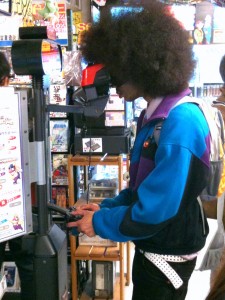 I admit it, I am a bit behind on this. First time I heard of it was in a Penny Arcade strip around two months ago. The second time was on a gaming forum. After that I started paying more attention and noticed that people are talking about it all the time. Some love it, some are less enthusiastic. I am talking about Oculus Rift.
I admit it, I am a bit behind on this. First time I heard of it was in a Penny Arcade strip around two months ago. The second time was on a gaming forum. After that I started paying more attention and noticed that people are talking about it all the time. Some love it, some are less enthusiastic. I am talking about Oculus Rift.
For those of you who are going “the what now?”, here’s a summary. Oculus Rift is a head-mounted video display. Think about a set of fancy 3D goggles that you connect to your PC/game console/whatnot. With an immensely successful Kickstarter campaign in 2012 ($250,000 in four hours), Oculus Rift broke through to the gaming scene and people haven’t shut up about it since. Frankly, I’m surprised I managed to stay unaware of it as long as I did. The thing about Oculus Rift is that instead of just being a display, it also tracks the user’s head movement and lets them look around the game world as if they were actually there. It has been praised for providing unprecedented immersion to video games, but also criticized for inducing motion sickness and its relative pointlessness.
As much I would love to try this thing out, I can’t afford to blow 300 dollars on a fancy computer display at the moment. So, since I’m unable to actually review the thing, I’m gonna rave about the implications Oculus Rift sets. I’ll start by saying that as a raging technophile, I am going to be extremely biased here: I love everything about Oculus Rift (petition for marriage pending until an actual test-drive).
I remember when back in the 90s, the gaming industry was (at least for a while) all about virtual reality. As technology was developing so fast and games were getting better and more beautiful, it was a natural assumption that total immersion would soon follow. Companies kept making these weird VR glasses and goggles, and Nintendo even created a whole console around the project, the infamous Virtual Boy. Some companies even worked on primitive motion detection technology, letting players control virtual objects by moving their bodies.
Sadly, all these innovations flopped. VR glasses were uncomfortable to wear, their display resolution was pathetic, and perhaps most importantly, they had the potential to cause massive vision damage. Nintendo’s Virtual Boy never rose up to its full potential (the thing had a two-tone display for Pete's sake) and so it was promptly mocked out from game stores and abandoned by the company. By the turn of the millennium, everyone had forgotten about virtual reality and moved on. The technology just wasn’t there yet.
Now, it’s different. We’ve had full-body motion control for years (thanks Wii and Kinect!). We have 5.1 surround audio headphones. The only thing we were lacking was the visual element. Enter Oculus Rift.
It seems that Oculus Rift has somehow managed to overcome most of the problems early display goggles struggled with. Correctly configured games have blown minds on several gaming blogs. Kotaku's Richard Eisenbeis called the level of immersion when playing Half-Life 2: Episode 1 an “unreal experience … I wouldn't give that up for the world.” Yet Oculus Rift provides more than just immersion. Reviewers have noted that Oculus Rift also increases performance in games such as first-persons shooters. Aiming and getting those precious headshots is much easier when you can actually peek out from behind cover without exposing half of your torso.
Unfortunately, Oculus Rift is as of yet far from perfect. Reviewers, Eisenbeis among them, have commented on the as of yet pretty low resolution of the display (1270x800) and the size and weight of the goggles. Using the device also has a nasty but largely inevitable side-effect: incorrectly configured games may cause visual pain or downright nausea. Though they have pointed out the problems, the reviewers have also acknowledged that they are using a developers' version. The actual consumer market variant, the Oculus Rift 2.0, is going to boast a full 1080p display, be smaller and lighter, and undoubtedly have wider support for different games.
Oculus Rift might seem to be just a curious novelty for now, but mark my words, despite it's current childhood issues, we are dealing with the future here. Immediately when the rough edges have been smoothed out and a reasonably-sized variant or competitor of Oculus Rift comes out (shouldn’t be more than a few years), we are going to see these things being plugged into handheld devices. Imagine it: a subway train full of people, all wearing a pair of display glasses, isolated in their own little bubble of reality. It’s dystopian, it’s alarming, and it’s beautiful.
This course of development seems inevitable, when you start to think about it. The gaming market is always looking for the next big thing. Motion control, be it a touch screen or Kinect, played a big part in the rise of “casual” gaming, bringing games to the masses. Virtual reality displays might just be the next big hit.
Thus far video games have put the camera into first person. For years games suffered from the “floating eye” syndrome - there was a gun or hands on the screen, but when you looked down, you saw no feet. Then the camera was stuffed into the actual player model’s head and you could see your appendages flail around as you ran/jumped/shot/cleaved your way through the game. But that’s as far as a traditional display can go immersion-wise. The player will still be only looking at a flat picture.
So, will Oculus Rift cause a technological revolution in the way motion control did? Not in its current incarnation, but in the future – once it gets smaller and less power-hungry – it has all the potential to do so. It's easy to see people buying Oculus Rift for the same reasons they buy noise-canceling earbuds: we like to be alone with our entertainment.
The added immersion is not a factor to be ignored either. 3D movies have not been the smash-hit they were expected to be, but Oculus Rift might bring virtual reality into movies as well. First, the technology works differently than those 3D glasses everyone seems to hate. Second, imagine watching a movie where you could look around the set and notice details that current technology just won't let you. Of course, this is all speculation, but I'd dare call it realistic speculation. It all depends on the willingness of the masses to give Oculus Rift a chanceS and making the device comfortable to wear and use. During this initial development period, Oculus Rift's success with video games will be the deciding factor. And think about it, how awesome would it be to actually be able to turn your head, look down from a cliff, and watch gusts of wind shake the treetops of Skyrim.
I could stop here, but I won’t. I get shamelessly excited about nearly every new cutting-edge piece of technology and start thinking about the far future and where it could take us. The answer here is simple: the Matrix, man. All we need now is a way to control the game environment by thought alone, something that companies such as Emotiv are already working on. Once we give birth to the requisite race of malevolent, A.I-driven machine men, we can safely be locked away in glass tanks filled with a nutrient-rich sludge, living in our own perfect little virtual universes.
I, for one, welcome our new machine overlords. Until then, I’m going to go camp outside Gamestop so I’ll be first in line when Oculus Rift 2.0 comes out.
